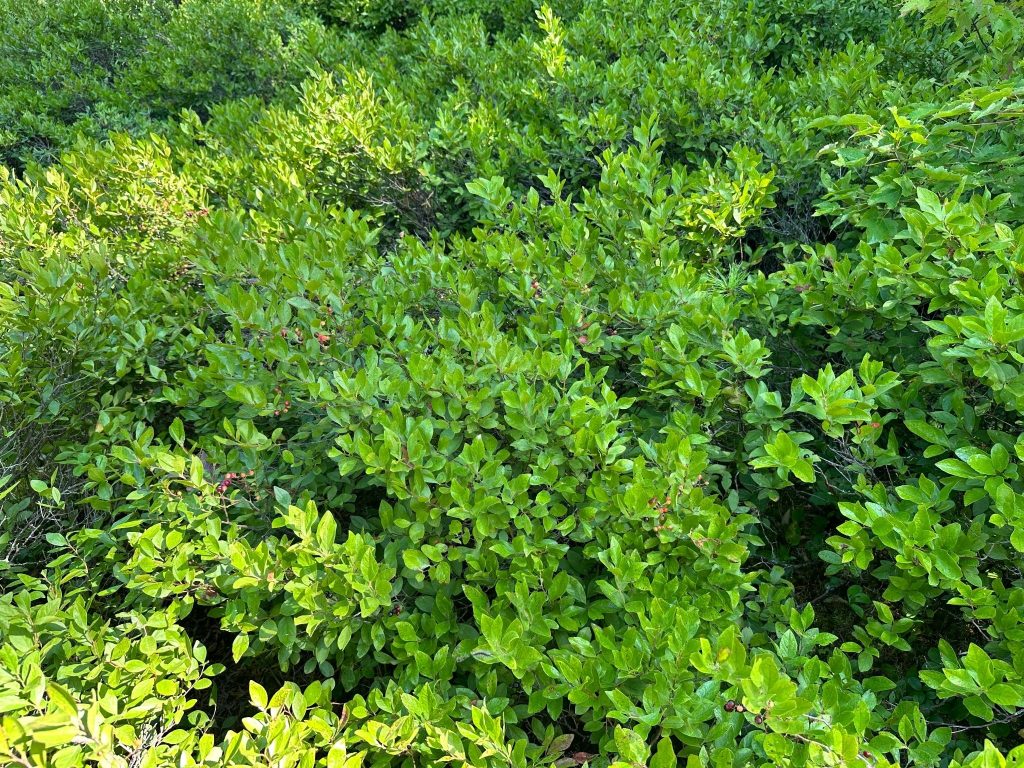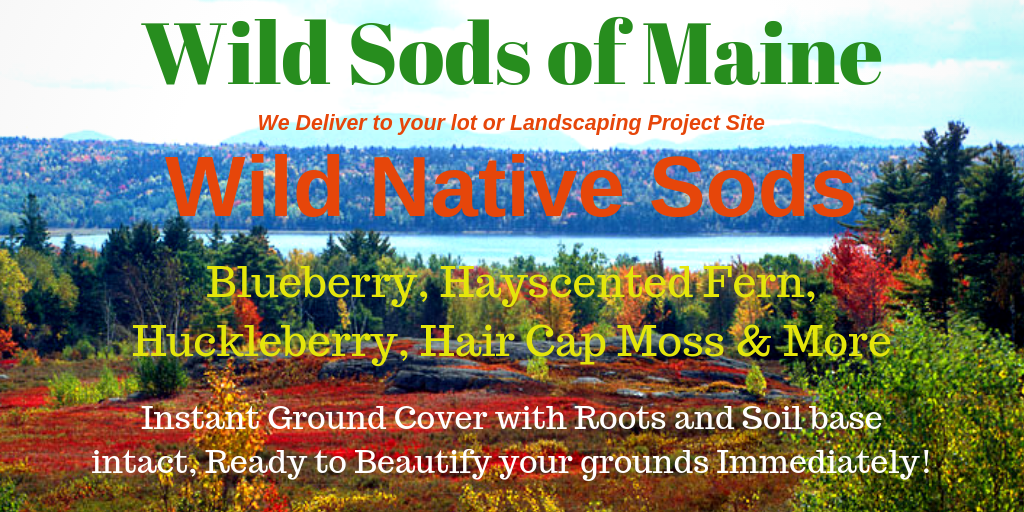Black Huckleberry Sod for Landscaping

Introduction
Transforming your outdoor space with Huckleberry sod creates a stunning landscape that stands apart from traditional garden designs. These versatile plants bring a unique blend of beauty and functionality to your property, making them an excellent choice for both residential and commercial landscaping projects.
Huckleberry plants deliver remarkable benefits to your outdoor environment:
- Natural soil enrichment through organic matter decomposition
- Creation of wildlife habitats, attracting birds and beneficial insects
- Stunning aesthetic appeal and year-round visual interest with seasonal color changes
- Low maintenance requirements once established
- Excellent erosion control on slopes and banks
Understanding the Black Huckleberry Plant
Black Huckleberry (Gaylussacia baccata) is a remarkable native shrub, growing 1-3 feet tall with a spreading growth pattern. These compact plants have:
- Dark green, oval leaves that turn vibrant scarlet in fall
- Small, bell-shaped pink or white flowers in spring
- Clusters of edible black berries in late summer
- Dense branching structure ideal for ground coverage
Growth Requirements
- Soil pH: 4.5-6.0 (acidic)
- Light: Partial to full sun
- Moisture: Well-draining soil
- Hardiness: Zones 3-7
Black Huckleberry plants thrive in woodland settings, making them perfect for naturalized landscapes. Their adaptability to various soil conditions allows successful growth in sandy, clay, or loamy soils.
Landscape Benefits
- Creates natural wildlife habitats
- Attracts pollinators and songbirds
- Prevents soil erosion on slopes
- Provides year-round visual interest
- Requires minimal maintenance once established
The plant’s compact root system makes it ideal for erosion control on hillsides. Its berries serve as a food source for local wildlife, while its dense foliage provides shelter for small animals and birds. The plant’s natural resistance to deer and drought adds to its appeal as a low-maintenance landscaping choice.
These hardy shrubs form effective privacy screens when planted in groups, creating natural boundaries while supporting local ecosystems. Their ability to spread through underground runners helps establish stable ground cover in challenging landscape areas.
- Visual focal points – Using Huckleberries to create stunning garden features
- Property value – Maximizing curb appeal through strategic design choices
Key Elements of a Well-Designed Landscape with Huckleberries
A successful landscape design incorporating Black Huckleberries may include both hardscape and softscape elements. These components work together to create a balanced, functional outdoor space that showcases the natural beauty of Huckleberry plants.
Suggested Hardscape Features:
- Stone pathways that wind through Huckleberry patches
- Decorative fencing to provide support for climbing varieties
- Raised beds specifically designed for Huckleberry cultivation
- Strategic patio placement to create viewing areas
Complementary Softscape Elements:
- Companion plants that share similar soil requirements
- Shade trees to protect Huckleberries from intense afternoon sun
- Ground covers to prevent soil erosion
- Native plants to attract beneficial pollinators
The placement of these elements creates distinct garden zones that highlight Huckleberries’ versatility. Patios positioned near Huckleberry patches allow you to enjoy their fragrant blooms and seasonal color changes. Strategic fence placement provides wind protection and creates micro-climates where Huckleberries thrive.
Incorporating water features near Huckleberry plantings adds ambient sound while maintaining necessary humidity levels. The combination of textures – from smooth stone pathways to the layered foliage of Huckleberries – adds visual interest throughout the seasons.
A well-executed design balances these elements to create outdoor spaces that feel both natural and intentional. The careful selection and positioning of each component ensures your Huckleberry landscape remains beautiful and functional year-round.
Enhancing Outdoor Spaces with Customized Designs Incorporating Black Huckleberries
Your outdoor space tells your unique story. You can create a personalized landscape that reflects your lifestyle, preferences, and your property’s characteristics. A customized design approach ensures your Black Huckleberry installation maximizes both aesthetic appeal and functionality.
Popular Black Huckleberry Design Styles:
- Modern Minimalist: Clean lines with geometric Huckleberry arrangements, strategic placement against contemporary hardscaping, monochromatic color schemes highlighting Huckleberry’s natural hues
- Rustic Cottage: Natural, flowing Huckleberry borders, integration with wildflower meadows, informal pathways winding through Huckleberry patches
- Japanese-Inspired: Layered Huckleberry plantings creating depth, Zen garden elements complementing berry clusters, strategic pruning for artistic shapes
Benefits of Incorporating Huckleberry Plants in Landscaping
Huckleberry plants transform ordinary landscapes into vibrant, multi-functional spaces that delight both eyes and taste buds. These versatile shrubs create stunning visual displays with their:
- Delicate white or pink bell-shaped flowers in spring
- Rich green foliage that turns brilliant red in fall
- Clusters of colorful berries ranging from deep purple to bright red
The aesthetic value extends beyond seasonal changes. You can use huckleberries to:
- Create natural privacy screens
- Design eye-catching border plantings
- Add texture to woodland gardens
- Establish focal points in landscape designs
Your garden becomes a productive space with huckleberry’s edible benefits. The berries offer:
- Sweet-tart flavor perfect for pies, jams, and preserves
- High antioxidant content
- Fresh snacking options right from your backyard
- Unique ingredient for homemade wines and syrups
The environmental impact of huckleberry plants enriches your garden ecosystem:
- Attracts essential pollinators like bees and butterflies
- Provides food and shelter for local birds
- Supports native wildlife populations
- Creates habitat connectivity in urban areas
These hardy plants also contribute to sustainable landscaping practices by:
- Reducing water needs once established
- Preventing soil erosion with strong root systems
- Requiring minimal chemical interventions
- Adapting well to local growing conditions
Using Huckleberry Sod in Landscaping Projects:
Tips and Tricks
Huckleberry sod offers a quick-establish solution for your landscaping needs. This pre-grown mat includes a network of established huckleberry plants with their root systems intact, providing immediate ground coverage and stability.
Sod vs. Seeds or plants: Key Advantages
- Instant aesthetic appeal and ground coverage
- Reduced erosion risk
- Faster establishment compared to seeds or plants
- Less maintenance during initial growth phase
- Better weed resistance due to established root systems
Installation Best Practices
Site Preparation
- Remove existing vegetation
- Level the ground surface
- Add 2-3 inches of quality topsoil
Installation Steps
- Lay sod pieces tightly together
- Stagger seams like brick patterns
- Press on installed sod to ensure soil contact
- Water immediately after installation
Post-Installation Care
- Keep soil consistently moist for 2 weeks
- Avoid foot traffic during establishment
- Apply slow-release fertilizer after 6 weeks
Timing Your Planting
Plant huckleberries in early spring or fall. Spring planting gives roots time to establish before summer heat, while fall planting helps roots develop before winter dormancy.
Your soil preparation directly impacts plant success. Rich, well-draining, acidic soil creates ideal growing conditions for healthy huckleberry plants. Adding a 2-3 inch layer of mulch helps retain moisture and suppress weed growth.
Caring for Huckleberry Plants in Your Landscape Design
Your huckleberry plants need specific care to thrive and produce abundant berries. Here’s what you need to know about maintaining healthy huckleberry plants in your landscape:
Watering Requirements
- Water deeply 1-2 times per week during growing season
- Keep soil consistently moist but not waterlogged
- Reduce watering during dormant winter months
- Apply mulch to retain moisture and regulate soil temperature
Fertilization Schedule
- Feed plants with acid-based fertilizer in early spring
- Apply balanced organic fertilizer monthly during growing season
- Use compost tea as a natural nutrient boost
- Avoid over-fertilizing to prevent leaf burn
Strategic Pruning
- Remove dead or damaged branches in late winter
- Thin out crowded stems to improve air circulation
- Cut back older branches to encourage new growth
- Shape plants to maintain desired size and form
Pest and Disease Management
- Watch for common pests like aphids and spider mites
- Monitor leaves for signs of fungal diseases
- Use organic pest control methods like neem oil
- Remove affected plant parts immediately to prevent spread
Year-Round Care Tips
- Check soil pH regularly – maintain between 4.5-6.0
- Protect plants from harsh winds and extreme temperatures
- Clean up fallen leaves and debris around plant base
- Install protective netting during berry season to deter birds
These care practices help establish robust huckleberry plants that enhance your landscape while providing delicious berries for years to come.
Creating a stunning landscape with huckleberry sod can transform your outdoor space into a sustainable, edible garden paradise.
Your dream of a beautiful, productive landscape is within reach. Picture yourself harvesting fresh berries while enjoying a meticulously maintained garden that supports local wildlife and enhances your property’s value.
Your landscaping journey Awaits… with your imagination, proper planning and some beautiful Black Huckleberry sod.

